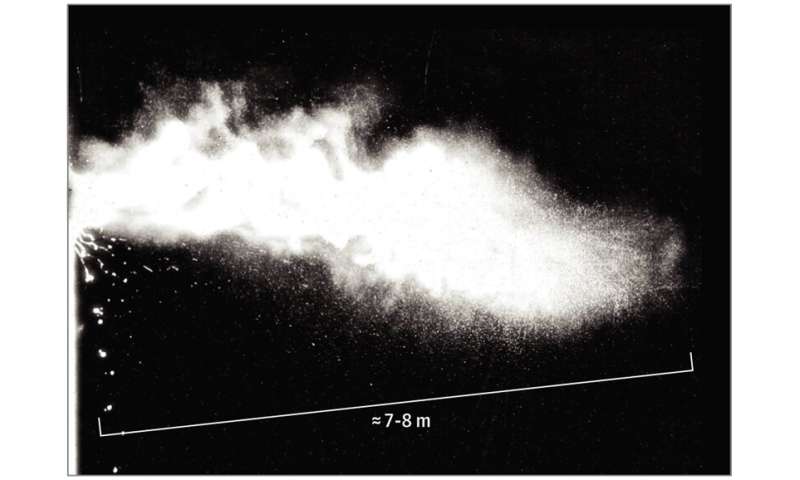
The novel coronavirus has prompted social distancing measures around the world. One researcher believes what’s being done isn’t enough.
Lydia Bourouiba, an associate professor at MIT, has researched the dynamics of exhalations (coughs and sneezes, for instance) for years at The Fluid Dynamics of Disease Transmission Laboratory and found exhalations cause gaseous clouds that can travel up to 27 feet (8.2 meters).
Her research could have implications for the global COVID-19 pandemic, though measures called for by the Centers for Disease Control and Prevention and the World Health Organization call for six and three feet (0.9 m and 1.8 m) of space, respectively.
“There’s an urgency in revising the guidelines currently being given by the WHO and the CDC on the needs for protective equipment, particularly for the frontline health care workers,” Bourouiba told U.S. TODAY.
Bourouiba’s research calls for better measures to protect health care workers and, potentially, more distance from infected people who are coughing or sneezing. She said current guidelines are based on “large droplets” as the method of transmission for the virus and the idea that those large droplets can only go a certain distance.
In a Journal of the American Medical Association article published last week, Bourouiba said peak exhalation speeds can reach 33 to 100 feet per second (36 km/h and 110 km/h) and “currently used surgical and N95 masks are not tested for these potential characteristics of respiratory emissions.”
The idea that droplets “hit a virtual wall and stop there and after that we are safe,” is not based on evidence found in her research, Bourouiba said, and also not based on “evidence that we have about COVID transmission.”
Bourouiba argued that a “gaseous cloud” that can carry droplets of all sizes is emitted when a person coughs, sneezes or otherwise exhales. The cloud is only partially mitigated by sneezing or coughing into your elbow, she added.
“In terms of the fluid regime—how the exhalations are emitted—the key point that we have shown is that there’s a gaseous cloud that carries droplets of all sorts of sizes, not ‘large’ versus ‘small’ or ‘droplets’ versus ‘aerosols,'” she said.
How far can coronavirus germs travel ‘before they’re no longer a threat’?
Dr. Paul Pottinger, an infectious disease professor at the University of Washington School of Medicine, said questions remain about the distances at which the virus is effective.
“For me, the question is not how far the germs can travel, but how far can they travel before they’re no longer a threat. The smaller the germ particles, the lower the risk that they might infect somebody who would breathe them in or get them stuck in their nose or their mouth,” Pottinger told U.S. TODAY.
“The biggest threat—we think—with the coronavirus is actually the larger droplets. Droplets of saliva, snot, spit. Droplets that almost look like rain, if you will, when someone sneezes. Those droplets are large enough that gravity still acts on them. Usually, within about six feet of leaving somebody’s body, those larger, more infectious droplets will drop to the ground. That’s where the six-foot rule comes from.”
WHO referred to a recent scientific brief on the methods of transmission, which recommended “droplet and contact precautions for those people caring for COVID-19 patients.” The CDC did not respond to an emailed request for comment.
“WHO carefully monitors emerging evidence about this critical topic and will update this scientific brief as more information becomes available,” WHO said in a statement. “WHO welcomes modeling studies, which are helpful for planning purposes. WHO teams work with several modeling groups to inform our work.”
If the coronavirus were effective at ranges of up to 27 feet (8.2 meters), as Bourouiba contends in her research, Pottinger said he believes more people would be sick.
“It takes a certain number of viral particles, we call them ‘virions,’ or individual viruses, it takes a certain number of individual viruses to actually get a foothold inside the body and cause that infection to get going,” he said.
“Now, we don’t know exactly what that number is, but it’s probably more than a single virus. If you think about it, if this really traveled very efficiently by air, we wouldn’t be having this conversation. Everybody would know it’s true because everybody would be infected. If it was a 27-foot radius that was a high risk to somebody, this would be a totally different conversation. It’s not.”
Bourouiba said she wants to see recommendations made based on current science not “policies based on supply, for example, because we don’t have enough PPE (personal protective equipment).” It’s well-known PPE is in short supply nationwide and health care workers have been desperately trying to find effective ways to deal with shortages.
“Although there remains a lot of questions to be addressed about how much virus is at a given distance or not, we have no answer one way or another at this time,” she said. “Therefore, the precautionary principle should drive the policies to state that we should have high-grade respirators used for health care workers.”
Source: Read Full Article
